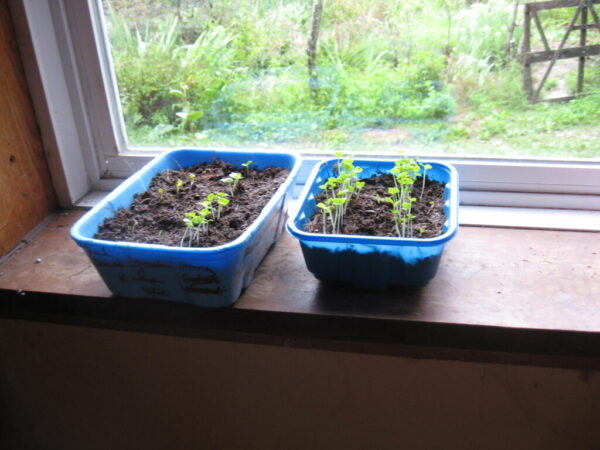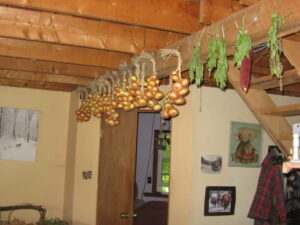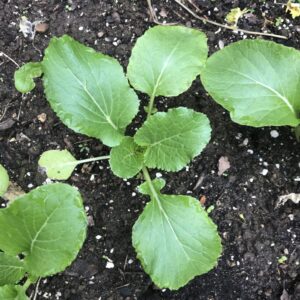- Like
- Digg
- Del
- Tumblr
- VKontakte
- Buffer
- Love This
- Odnoklassniki
- Meneame
- Blogger
- Amazon
- Yahoo Mail
- Gmail
- AOL
- Newsvine
- HackerNews
- Evernote
- MySpace
- Mail.ru
- Viadeo
- Line
- Comments
- Yummly
- SMS
- Viber
- Telegram
- Subscribe
- Skype
- Facebook Messenger
- Kakao
- LiveJournal
- Yammer
- Edgar
- Fintel
- Mix
- Instapaper
- Copy Link
A version of this column first ran in the Roane County (WV) Reporter and Times Record. Support local journalism! Subscribe to your local newspaper. This is one of a series of blogs for new gardeners. Start reading the whole series here: Part 1.

Brassica seedlings getting a start indoors for their growth into fall.
The time has come to plant some late crops. Many of these are brassicas—broccoli, Chinese cabbage, bok choy, cauliflower and kale—and these are more easily started in pots indoors. Yes, you can start them right in place, but if it gets hot and dry they may not germinate, and you will have to defend your tiny seedlings against weeds and bugs and perhaps other hazards. It’s easier to start them inside and then transplant them out when they’re big enough to defend themselves, plus it will begin to cool off not long after that.
Brassicas don’t like heat. The time to start these is right now. Or preferably last week but it’s not too late if you do it right now. Mustard greens and collards can be direct sown. In the case of mustard, it can be sown even in September—it’s very hardy.
For three things, it’s too early: spinach, lettuce and radishes. Plant these outside in late August or even in September. They won’t germinate well now as it’s too warm. They are also quite hardy; spinach and lettuce can survive all winter with a little cover. You don’t want to leave it too late, though, as they won’t really grow in winter.

Onions and basil drying.
Another thing it isn’t yet time to plant is garlic. That goes in the ground in fall, typically some time in October. But you should have all your garlic and onions harvested and cured by now; the remaining thing to do is check over your stash about once a month to find any soft ones, so the rot doesn’t spread to the others in the bag or braid or bin. This also applies to potatoes.
Carrots, beets and turnips can all be planted now. It may be chancy as to whether they will produce adequate growth before winter sets in, but if they do, they’re all hardy and will keep in the ground into early winter, especially if covered with some mulch. But sometimes voles get at them and chew holes in them. This also goes for potatoes, which may be left in the ground until wanted—at risk of vole damage. Potato tubers must be well covered by soil; if exposed to sunlight, the skins will turn green, indicating the presence of poisonous alkaloids.
The tricky thing about planting carrots now is that they must be kept moist for the week or more until they germinate, and the weeks after they come up in which they’re still tiny little feathery things. Ideally you pick a time to plant in which we have a lot of clouds and rain.
Some things you can plant this late if you choose quick cultivars and are lucky on weather: peas, beans, maybe sunflowers (the seeds make fine chicken and bird food), and summer squash. You may think that the last thing you need is to plant more squash if you have a green machine spitting out zucchinis like a machine gun spits out bullets…but I find that the plants get old and tired, tattered and cranky. If you have a young, healthy plant ready to take over around September first, you can rip out the ugly old one.
It may be time to think about cover crops to hold your ground over the winter (Farmers Friend sells seed for these). In my raised beds, I mostly use winter peas and vetch. These both fix nitrogen, are quite hardy, and are easily removed in spring. The peas are a nice addition to salads in winter and early spring—just pull off a few inches of the tips. As for the vetch, it makes pretty purple blooms if you let it go that long, and is hardy as stone (below zero will kill the peas). Another one you might want to use is daikon radish, which sends a long root a foot or more into the ground. It can take a light frost but will not survive the winter, so you need to start it before September first. When it dies and rots, it injects organic matter into your subsoil, breaking up a hardpan. I would like to use it more, but am always waiting too long, for some crop to be done that doesn’t come out till it frosts. In my flat ground, I use a combination of rye or wheat, and vetch. This often requires tilling before sowing in fall, and then to turn it under in the spring.
Read the rest: Part 1. Part 2. Part 3. Part 4. Part 5. Part 6. Part 7. Part 8. Part 9. Part 10. Part 11. Part 12. Part 13. Part 14. Part 15. Part 16. Part 17.













